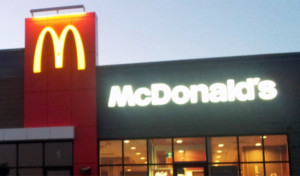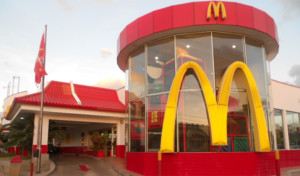Savvy retailers know that maximizing profits means smart marketing; This article captures two of the most well-known case studies in Quick Service Restaurants – Domino’s and McDonald’s…
The early 90s introduced the emerging trend of the pizza – thick, luscious slices slathered with a base of cheese and tomato sauce and toppings as the heart desired. Yet, it was Domino’s that brought order and variety into the pizza business and more importantly, more bang for your buck!
Insight based
The ‘30 Minutes or Pizza Free’ initiative that the brand launched in 2004 was a real game changer for the organization. This initiative was based on a very relevant customer insight: hunger cannot wait. More than a decade back, home delivery of food was not very common and was often laden with problems of delayed delivery and other issues. The brand packaged both these insights into a superlative product offering that provided delicious instant gratification, at any time or place the customer needed it. The joy of having a menu that actually appealed to the taste buds delivered in minutes was unprecedented in the F&B world. The chance of indulging in it without having to pay for it added a further temptation.
 Needless to say, ‘30 Minutes or Pizza Free’ is now synonymous
with Domino’s. The brand had already established pizza as a meal replacement rather than a snack. At the time of its launch, the advertising campaign showcased the superlative acting prowess of Paresh Rawal to drive home the message. “Since pizza was still a relatively new experience for Indians (back then), the aim of the campaign was to connect the brand with the average Indian by creating a real life, believable character. Paresh Rawal’s comic timing, coupled with the insight of how people adopt various tricks to save money, worked in connecting with the customers while communicating the 30 minutes or free message to the audiences”, added Senior Vice President- Marketing, Domino’s Pizza, Murugan Narayanaswamy.
Needless to say, ‘30 Minutes or Pizza Free’ is now synonymous
with Domino’s. The brand had already established pizza as a meal replacement rather than a snack. At the time of its launch, the advertising campaign showcased the superlative acting prowess of Paresh Rawal to drive home the message. “Since pizza was still a relatively new experience for Indians (back then), the aim of the campaign was to connect the brand with the average Indian by creating a real life, believable character. Paresh Rawal’s comic timing, coupled with the insight of how people adopt various tricks to save money, worked in connecting with the customers while communicating the 30 minutes or free message to the audiences”, added Senior Vice President- Marketing, Domino’s Pizza, Murugan Narayanaswamy.
 ‘Operations in a machine way
and people in a human way’ as a mantra also helped this initiative succeed. Timely delivery is now part of the company’s DNA. Domino’s is constantly measuring and improving its order to delivery cycle to ensure that efficiency is built and delivered every step of the way. In addition,
a robust training program, and an understanding amongst employees on how late deliveries could affect the outlet’s profitability has further contributed to its success.
‘Operations in a machine way
and people in a human way’ as a mantra also helped this initiative succeed. Timely delivery is now part of the company’s DNA. Domino’s is constantly measuring and improving its order to delivery cycle to ensure that efficiency is built and delivered every step of the way. In addition,
a robust training program, and an understanding amongst employees on how late deliveries could affect the outlet’s profitability has further contributed to its success.
Today, Domino’s is the undisputed leader in India’s $400m pizza market.
MCDONALD’S: Great Venue,
Greater Menu
 There was a time when a middle-class family ate out often, it became an object of envy among neighbours, and of course, speculation: “how do they manage it with his salary?”
There was a time when a middle-class family ate out often, it became an object of envy among neighbours, and of course, speculation: “how do they manage it with his salary?”
For a vast segment of Indian society, eating out had for long been a rare treat, a treat that was largely confined to the same outlets, where perhaps the quality of food played second fiddle to another, and more crucial, factor: price.
This reality was noticed, and subsequently addressed, by McDonald’s. When the international burger giant set foot on the shores of this country with the world’s largest middle-class, it immediately discerned a few pointers. One, eating out for most was still a luxury. Two, the burger, though iconic, was still a stranger to the Indian palate, and just Indianising its flavour would not be enough. Three, price was to be the company’s meal ticket, as it were.
Creating happy choices
 The ‘Happy Price’ Menu was the result and has been a source of continuous success since it was launched in 2004. The company’s advertising not only tickled the discount-seeking Indian with its star offering, the communication also reflected that every McDonald’s outlet was indeed a family venue with a happy menu. Fathers heaved a sigh of relief, children remained ecstatic, mothers got used to frequent breaks from the kitchen, and family seniors too celebrated an occasional departure from a doctor-recommended diet.
The ‘Happy Price’ Menu was the result and has been a source of continuous success since it was launched in 2004. The company’s advertising not only tickled the discount-seeking Indian with its star offering, the communication also reflected that every McDonald’s outlet was indeed a family venue with a happy menu. Fathers heaved a sigh of relief, children remained ecstatic, mothers got used to frequent breaks from the kitchen, and family seniors too celebrated an occasional departure from a doctor-recommended diet.
Robust supply chain tightens costs
 What perhaps may go unnoticed amid McDonald’s endless bid to befriend the wallet-conscious with a slew of new additions to its product roster is that the cost of the ‘Happy Price’ Menu has remained impervious to inflation. It started off at `20 and now has an extended menu priced at `25. The reason for this can only be viewed as yet another master-stroke on the part of this company – one that has, and suavely, managed to circumvent the middleman. From the outset, the company strove to forge a robust supply chain, allowing
it a direct interface with farmers and suppliers. This has helped it keep a tight rein on its operation costs – and the Happy Price Menu is thus happier for it.
What perhaps may go unnoticed amid McDonald’s endless bid to befriend the wallet-conscious with a slew of new additions to its product roster is that the cost of the ‘Happy Price’ Menu has remained impervious to inflation. It started off at `20 and now has an extended menu priced at `25. The reason for this can only be viewed as yet another master-stroke on the part of this company – one that has, and suavely, managed to circumvent the middleman. From the outset, the company strove to forge a robust supply chain, allowing
it a direct interface with farmers and suppliers. This has helped it keep a tight rein on its operation costs – and the Happy Price Menu is thus happier for it.
Director – Marketing & Digital, McDonald’s India West & South, Kedar Teny, elaborates further, “Our ‘Happy Price’ menu invites a price sensitive consumer on eating to their heart’s content without burning a hole in the pocket. The key offering here is good food at an affordable price”.
Imitation is flattery
 The two core ingredients which make Happy Price Menu special are good food and value for money. Sure, other international food chains have followed suit. Subway offered lesser priced variants such as ‘Sub of the Day’, an egg and mayo sandwich at `50 and toasties that were cheaper than their regular menu. KFC attempted to make its Wednesdays better by offering “12 for 300’’ for a bucket of chicken, but McDonald’s was there first. And is, even today.
The two core ingredients which make Happy Price Menu special are good food and value for money. Sure, other international food chains have followed suit. Subway offered lesser priced variants such as ‘Sub of the Day’, an egg and mayo sandwich at `50 and toasties that were cheaper than their regular menu. KFC attempted to make its Wednesdays better by offering “12 for 300’’ for a bucket of chicken, but McDonald’s was there first. And is, even today.
It was Domino’s that brought order and variety into the pizza business while Mcdonald's made the burger a household name while befriending the wallet conscious in India
Must Read


